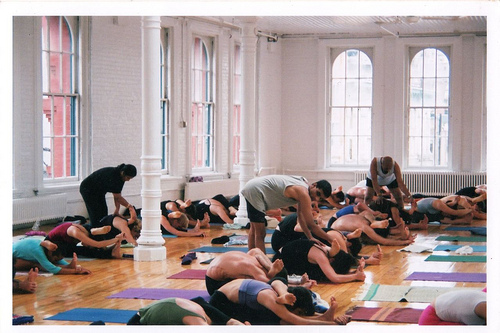I have been reading a lot of blogs by yoga teachers recently and hearing a lot of conversation among yoga teachers and students about the need to “respect your teacher” by following their instructions.
I have deep respect for my teachers. My teachers have deep respect for me. They know I come to their class because I appreciate their teachings; I come to their class because I need to breathe, to be led, to be grounded. Otherwise, I would and could practice at home.
I come to yoga to find clarity, to find freedom, to find me, separate from the expectations, the obligations, the fears, and the labels that I step onto my mat with. My time on my mat helps me explore what parts of my life no longer serve me, and what I can begin to work towards letting go of.
In order to find that clarity, to find my true self amid the muck, I need the freedom to explore: to explore my breath, to explore my movements and postures, to explore my mind.
When I am in a class where I do not feel free to explore, I feel restricted. I feel pressure to conform and to do as I am told. I feel suffocated. While I do learn from these suffocating experiences, they are not why I practice yoga.
Many teachers who want their students to follow their specific instructions have good reasons for this. Perhaps they have a brilliantly crafted sequence that requires building specific variations of one pose onto another or perhaps they know the body so well that they can offer us a different way to ease into a pose or help us prevent injury. Maybe they want us to find a deeper place. When my mind is clear, I find these offerings interesting, curious, and useful.
It is naive to believe that the teacher’s way is the only way to practice yoga. It is dis-empowering for the student. When yoga is most necessary for me; when I cannot take a full breath, when I do not know how to make it to the next moment, let alone the next day, a brilliantly crafted sequence or a new way to explore a pose are the last things on my mind. All I am trying to do is breathe.
I will never forget the first time I felt complete freedom in a yoga class.
Until this class, there were rules for every asana: my feet had to be flexed, my toes had to point up or down, my hips had to be square etcetera etcetera etcetera. It felt like there was a glass ceiling that I did not even know existed until I came to this class and broke through it into this brilliant lightness. I finally had permission to move my body into a place that felt good. Some of the traditional yoga postures feel good in my body, but others don’t. In this class I took, I found complete freedom in my body, which led to freedom in my mind and my spirit.
This is not to say that rule-bound yoga or strict codes of yoga do not have their place. They do. Some people fit into these styles of practice better than others and even I can appreciate an Ashtanga practice where I know what to expect and where I know what is expected of me. What should be recognized is that there is also a place for freedom of expression in yoga. It does not have to be either or. We are not disregarding a teacher’s experience and knowledge by doing a variation of a pose. We are listening to what our bodies, minds or spirits need at that point in time.
Some of the worst “offenders” also happen to be teachers. They are seen as disrespecting their fellow teachers by not following their exact instructions. My guess is that these offending teachers know their bodies and practices inside and out and have the confidence to follow their own paths. My offering to those who teach is that if we want our students to follow our specific instructions, give them a reason why. Trust that they are listening to what they need on that day while holding respect for us.
How we practice on our mats in a public space, much like how we conduct ourselves in our daily lives, comes down to the intention rather than what variation of a pose we are in.
Holding a handstand or an arm balance just for attention is disrespectful to everyone in the class. However, if one is holding a handstand to clear their mind, to have a break from the tears and the thoughts or to challenge their body and their mind in a safe space and a safe way, then that deserves respect.
I taught a class yesterday where my theme was freedom. As I stood at the corner of the room looking over all these different forms, it was amazing. Just as it is beautiful to watch a child play without a care in the world, it was breathtaking to watch a room full of beautiful souls find freedom amidst their busy lives.
Love elephant and want to go steady?
Sign up for our (curated) daily and weekly newsletters!
Editorial Assistant: Carrie Marzo/Editor: Bryonie Wise
Photo: Barry Silver/Flickr












Read 0 comments and reply